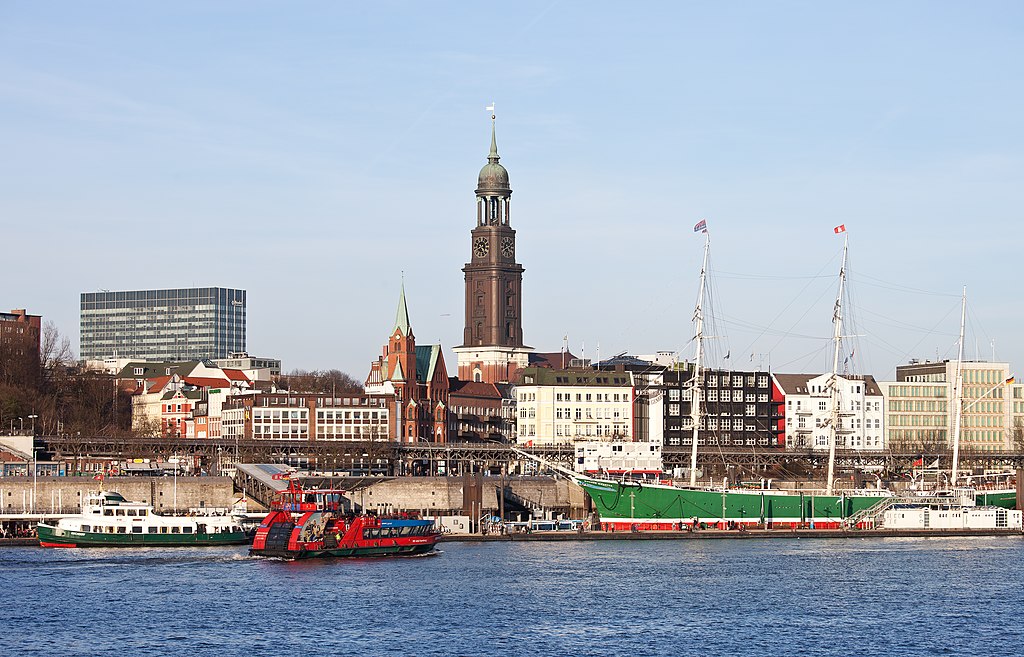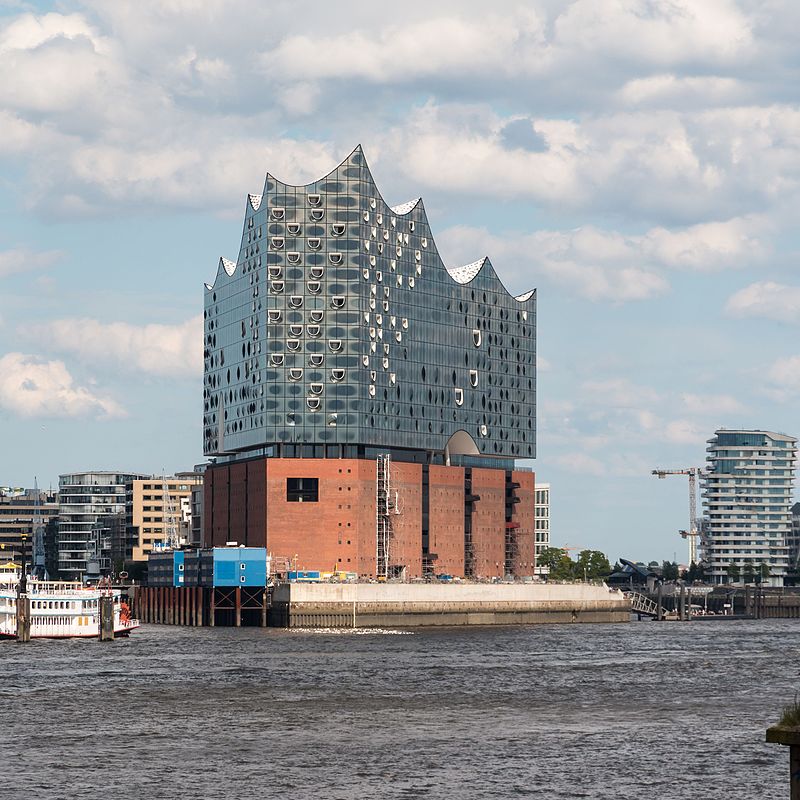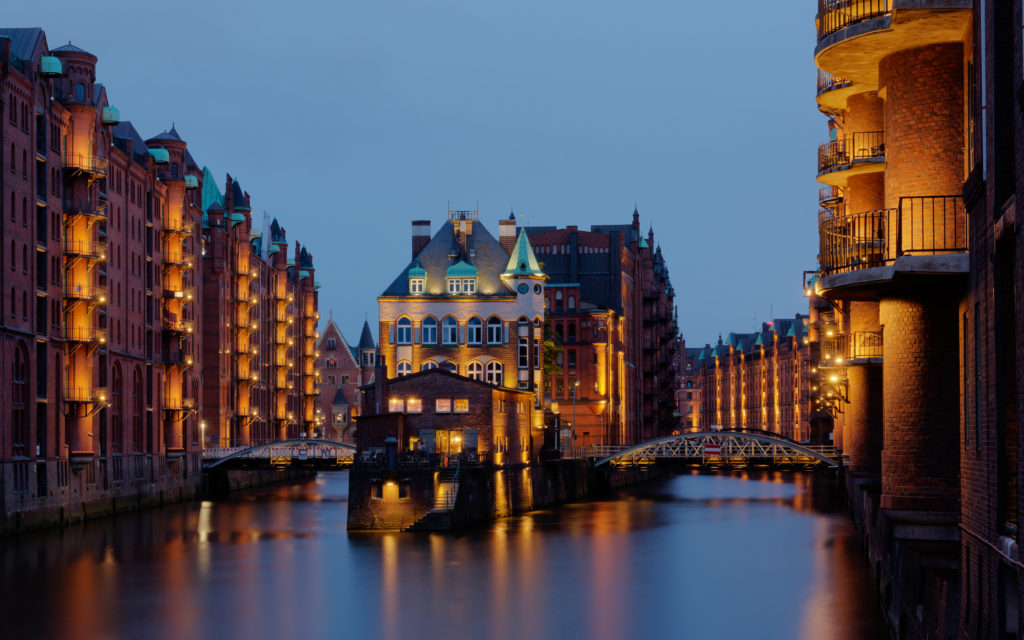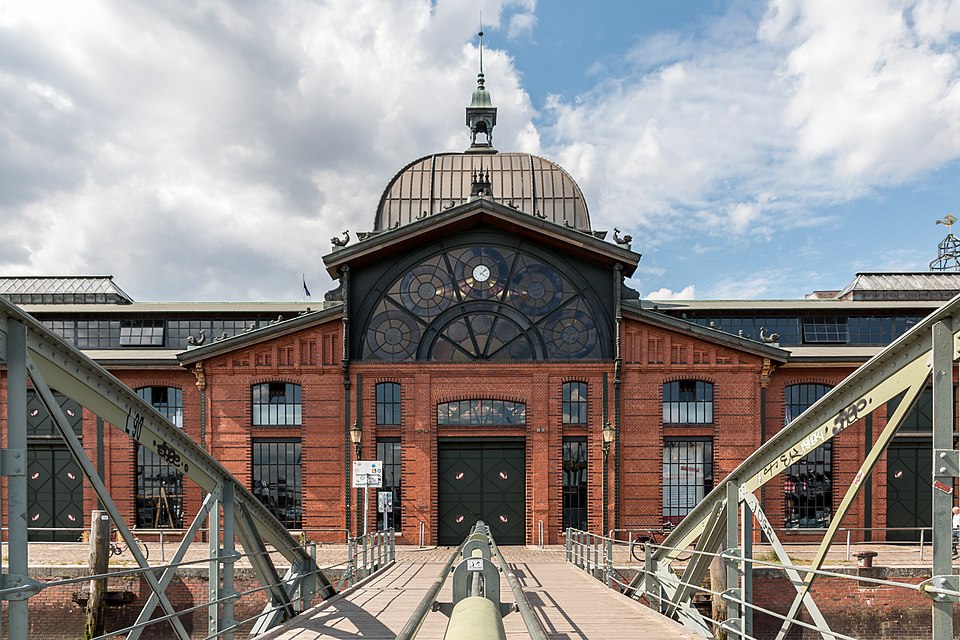Our multi award winning travel writer MAL ROGERS enjoys a weekend in Hamburg
 The Elbe landing stages with St Michael's Church in the background (picture by Thomas Wolf, www.foto-tw.de on Wikimedia Commons)
The Elbe landing stages with St Michael's Church in the background (picture by Thomas Wolf, www.foto-tw.de on Wikimedia Commons)IF a well-known travel website were to post a review of the Hotel California, it would run along the lines of:
PLUSES
- Such a lovely place? (YES 10 out of 10)
- Plenty of room at the Hotel California? (DEFINITELY – it stresses this in the chorus, so 10/10) "Plenty of room at the Hotel California, such a lovely place (such a lovely place. . .)"
- Open all year? YES Any time of year, in fact – again, confirmed in the chorus
- Mirrors on the ceiling? YES
- Pink champagne on ice? YES
- Good room service? (The captain is always available to bring you up your wine)
- Checking in: Any time you please
DRAWBACKS
- You can never leave
Now, my review of the Hotel Steigenberger in Hamburg would run:
PLUSES
- Such a lovely place? (YES 10/10)
- Plenty of room at the Hotel Steigenberger? (Over 200 rooms, so YES 10/10)
- Open any time of year? (YES)
- Mirrors in the ceiling? Not in my suite, thankfully
- Pink champagne on ice? They’ll serve pretty much anything on ice. I went for a Margarita with extra lime and hold the salt. Some cashews too.
- Good room service? Excellent. You get the impression that if you phoned reception and mentioned you’d a grá for, let’s say, a bucket of whipped cream, a Halloween mask and some spring onions, they’d be delivered immediately, no questions asked. Although not by the captain as in the Hotel California — even though Hamburg is one of the world’s great seaports.
- Checking in: there’s a 24-hour front desk at the Steigebberger and the receptionists speak several languages up to UN interpreter standard. They don’t regard your checking is an unwarranted impertinence, as has happened to me from time to time.
DRAWBACKS
- Unlike the Hotel California, at the Hotel Steigenberger you can leave any time you want, certainly, but they insist on you paying your bill.
The stylish Steigenberger
THE MAIN advantage of the Hotel Steigenberger, unlike Hotel California, is that it’s a luxury hotel in the centre of one of Germany’s great cities. And it’s a five-star property with remarkably keen prices.
A stylish masterpiece, all sleek stainless steel and glass in public areas, the rooms are understated and deeply luxurious. Breakfast buffets are the Full German – you could have muesli wrapped in smoked salmon should you so wish.
The Speicherstadt is right on the doorstep. This is probably the only collection of warehouses in the world to have UNESCO World Heritage status. Fair enough — it’s the largest conglomeration of sheds I've ever seen. They stand on great oak logs looking out over the canals. Red brick — a surfeit of red brick. You’ll have guessed why shedland is so big: this is the port of Hamburg, the HafenCity quarter. And hugely impressive it is. Once upon a time, or to be more exact in the 19th and 20th centuries, everything from coffee to cotton was unloaded here, one of Europe’s main commercial hubs.
The whole area, while still functioning as a major port, is festooned with some of the most futuristic architecture available in Europe with designs from architectural A-listers Rem Koolhaas and Renzo Piano. The pinnacle of imagination is arguably Herzog & de Meuron’s Elbphilharmonie (Elbe Philharmonic Hall) — Europe’s most outré concert hall and the city’s top identifiable landmark. This acoustically advanced concert hall, called the Elphi by locals and those in the know like you and me, needs to be visited. It is quite simply the most impressive venue in Europe. It stages first class gigs throughout the year, and at exceptionally cheap prices
www.elbphilharmonie.de
 "The Elphi" - Elbphilharmonie (Dietmar Rabich on Wikimedia Commons)
"The Elphi" - Elbphilharmonie (Dietmar Rabich on Wikimedia Commons)Ferries and fish rolls
HAMBURG is to ships what Salzburg is to Mozart or Clonakilty is to black pudding. The huge, historic harbour (a Unesco World Heritage Site) is situated 110km upriver, but large ocean-going vessels are easily accommodated. The River Elbe has simply washed wealth into the city since the Middle Ages.
The ocean-going cruise was invented here when one Herr Rob Sloman offered the world’s first cruise aboard his frigate ‘Germania’ way back in 1846. All aboard!
The best way to check out Hamburg is by boat – an armada of river and harbour cruises departs from Landungsbrücken in this massively maritimey city.
Catch the No 62 HADAG ferry (www.hadag.de). Part of the public transport system, it’s covered by your Hamburg Card — which by now the receptionist at the Steigenberger will have advised you to get. Might even have got it for you. You can disembark at the first stop Altona (Fischmarkt), the ornate market where The Beatles used to scoff breakfast after a hard day’s night.
The local speciality is fischbrötchen: seasoned herring in a crusty roll, served with raw onion. They’ve been chopping onions and gutting fish here for over 300 years and they've really got the hang of it.
Maritime Circle Line: This hop-on-hop-off service connects several maritime attractions in Hamburg's eastern port area, including the BallinStadt Emigration Museum, the Hafenmuseum Hamburg and the International Maritime Museum Hamburg,
Located in the historic Kaispeicher B warehouse in HafenCity, the Maritime's vast collection spans 3,000 years of maritime history, including ship models, naval uniforms, maritime art, and navigation instruments.
The Maritime Circle Line operates on a scheduled timetable, allowing you to explore the city's harbour at your own pace (laggardly, in my case)
www.maritime-circle-line.de/en/
Harbour Boat Tours – Barkassen-Meyer is one of the oldest private tour operators in Hamburg. Its guided tours nose through the port, the historic Speicherstadt, and modern HafenCity.
www.barkassen-meyer.de/en/
 Speicherstadt,Wasserschloss (image by Dietmar Rabich on Wikimedia Commons)
Speicherstadt,Wasserschloss (image by Dietmar Rabich on Wikimedia Commons)Sekt and the City
BACK in town, and we’re legging it to the Heiligengeistbrücke now, rocking alongside an extravagant number of waterways and lakes in the Free and Hanseatic City of Hamburg (as the place is pleased to call itself on formal occasions). Soon we’ll come to Walther Eisenberg’s, a traditional hat-maker on Steinstrasse. €80 will get you into a proper sailor’s hat as well as into the maritime mood.
Equipped with your new tug captain's headgear, you can head back to the hotel. The receptionist will be well impressed, I can tell you.
In the piano bar of the Steigenberger, over a glass of Sekt — the elegant German version of champagne — you can reflect that 80 years ago Hamburg was rubble. The war devastated Europe, and more or less flattened this city. But somehow its distinctive silhouette arose again as the place was rebuilt, literally brick by brick.
Today it’s a cultural, commercial and culinary success. As befits the city which gave its name to the most ubiquitous takeaway in the known universe, Hamburg boasts more eating places than you could reasonably shake a sauce bottle at.
The local specialty is – not a hamburger as you might expect—but the Labskaus: corned beef mashed with potato, onion and beetroot, which gives it a pink hue. At the Seemann’s Bistro on Hohe Brücke (just five minutes’ walk from the Steinberger) their solid take on the dish includes its being served with a fried egg, rollmops—pickled herring—and pickles.
The Krameramtsstuben on Krayenkam is often cited as the serving the finest Labskaus in the city. If there were a Nobel Prize for Labskaus, this place could be in the running. But you’ll also find other traditional north German dishes. I can personally vouch for the beef roulade. Oh, and if you still have room, a word in your ear: hot cinnamon plums, served with walnut ice cream.
 St. Pauli Fischmarkt, Fischauktionshalle (image by Dietmar Rabich)
St. Pauli Fischmarkt, Fischauktionshalle (image by Dietmar Rabich)From Hamburg with love
SOMEWHAT inevitably, we come to the Reeperbahn, in the St Pauli area.
This is where the Fab Five played — when The Beatles were a five piece (Stuart Sutcliffe on bass, Pete Best on drums). Somewhat unfortunately for Best, this is where the band first met Ringo Starr— in the Kaiserkeller.
Deep into the Reeperbahn now, and should you be of a sensitive disposition, it’s time to avert your eyes. This remains one of biggest red-light areas in Europe, but also boasts theatres, music venues, and history. Rock & roll and red lights, if you will. Vibrant, edgy, and iconic, it’s a must-see for visitors. It features many business people (mostly ladies) who are prepared to extend maximum cordiality to you, for a negotiable fee. But the Reeperbahn can be exhilarating too, without partaking of its standard fare – on a Saturday night it can make Temple Bar seem like a convention of Finnish pastors.
At Christmas, a huge fair joins the fray, cheek by jowl with some of Germany's best theatres, alternative music venues and uber-cool bars. The area has moved effortlessly from seamy to Bohemian.
Now that so many places have sold their souls to mass tourism, it’s good to visit this rugged, cosmopolitan port run on behalf of both locals and travellers. I enjoyed Hamburg friendliness on several occasions during my weekend, and not just the lady in the Reeperbahn who asked in a delightful accent: “You wanna come in?” (As politely as I could – particularly as this was a weekend of mindfulness for me – I declined.)
 Wandbereiterbrücke (image Dietmar Rabich / Wikimedia Commons / Hamburg, Speicherstadt, Block P)
Wandbereiterbrücke (image Dietmar Rabich / Wikimedia Commons / Hamburg, Speicherstadt, Block P)Hamburg wears it well
HAMBURG, sometimes referred to as the bourgeois capital of Germany, is home to designer shops, great department stores, top-notch fashion houses and designer boutiques who will be delighted to relieve you of all your worldly assets. The Neuer Wall and Mönckebergstrasse draw well-heeled locals and stylish tourists alike.
It's not really my cup of tea, so I'll leave it with you. Although I can recommend the jaunty tug-boat captain's hat.
INFO
Thanks to Hamburg Marketing and the Hamburg Tourism www.hamburg-tourism.de/
Thanks to the Hotel Steigenberger www.steigenberger.com
Thanks to the following photographers:
Dietmar Rabich (https://www.rabich.de/)
Thomas Wolfe (www.foto-tw.de)
Fabian Sandner

